Christopher Llewellyn Reed’s Take on 2019 Tribeca, Part 2: Top Ten Movies
Written by: Christopher Llewellyn Reed | May 15th, 2019

Last week, I posted a recap of my VR/AR/Immersive experiences at the 2019 Tribeca Film Festival. Now it’s time to return to my main wheelhouse of standard, non-360º cinema, with my top 10 movies: 5 fiction and 5 documentaries. What follows are capsule reviews of each film. In the fiction category, I have only, so far, written one longer review for Hammer to Nail, the online magazine where I am lead film critic, of Burning Cane, winner of juried awards for Best Narrative Feature and Best Actor in a U.S. Narrative Feature, and I excerpt from that review here. For the other fiction films, I just write brief summaries of my thoughts. In the documentary category, I have already published four of the five reviews at Hammer to Nail, and similarly excerpt those reviews in the text, below. Enjoy!
Top Five Fiction Films (in alphabetical order):

Burning Cane (Phillip Youmans) [adapted from the longer review I wrote for Hammer to Nail]
Phillip Youmans’ debut feature Burning Cane is many things, among them the following: a lyrical meditation on the nature of faith, an examination of the ravages of addiction, a thoroughly engaging drama made on a shoestring budget, and, most amazingly, a movie whose director was still in high school when he shot it (and he was also the cinematographer, to boot). Set in an African-American community in rural Louisiana, the film focuses on a family ravaged by alcoholism and the flawed preacher to whom they turn for solace. Unfortunately, said man of cloth – played by the great Wendell Pierce (Four) – is, himself, prey to the siren call of spirits (of the 80-proof variety, that is), and in need of as much saving as those he serves. The Lord may work in mysterious ways, but here he has Youmans to beautifully document his mess on earth.

Luce (Julius Onah) [I also included the below summary in my pre-Maryland Film Festival piece]
A riveting, complicated filmic essay on race, gender, colonialism, class, power and privilege (white and otherwise), Julius Onah’s Luce presents its deeply flawed characters as actors in a drama with predetermined rules against which they strain, often helplessly. Kelvin Harrison Jr. (Monsters and Men) plays the titular character, a young man adopted from war-torn Eritrea by white parents, played by Naomi Watts (While We’re Young) and Tim Roth (The Padre), who, now 17, has become the star of his high school, both academically and athletically. One teacher, however, played by Octavia Spencer (Hidden Figures), has her doubts about Luce’s perfection, and the questions (benevolent? you decide!) she raises unleash a series of consequences that will test all involved. What price an inspiring narrative? Is it worth it to raise up “one Obama” (as a classmate designates Luce) to cast off those who don’t measure up? Everyone here is a fully realized human being, which makes the movie, adapted from J.C. Lee’s eponymous play, so compelling, even as each person disappoints (as people are wont to do) in some way. Fortunately, the movie does not: Luce is first-rate cinema.
Pearl (Elsa Amiel)
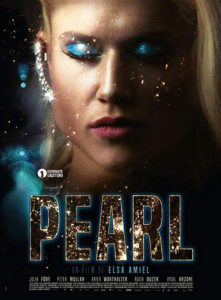
Bodybuilding star Julia Föry astounds in director Elsa Amiel’s gripping drama Pearl, which follows its titular protagonist on what should be a day of triumph as she competes to win a prestigious championship. Though hardly happy – enmeshed in an unhealthy codependent relationship with her trainer, played by a very fine Peter Mullan (Jacob Snell on Netflix’s Ozark) – she is at least singularly focused on the being the best in her field, a focus sorely tested when her troubled ex shows up with their young son, whom he leaves with her to pursue one of his many ill-conceived money-making schemes. As she struggles to balance work and unwanted motherhood, Pearl must figure out how to succeed on her own terms, not an easy task in a world dominated by male desire. Amiel makes a stunning feature debut in this taut narrative, simultaneously simple and complex.

Plus One (Jeff Chan/Andrew Rhymer): winner of the Narrative Audience Award
A fun romp of a rom-com, Plus One is like a millennial Four Weddings and a Funeral, only without the latter component, and with 12 weddings in total. Starring Maya Erskine (When Jeff Tried to Save the World) and Jack Quaid (Aberrant) as best buds from college who decide to be each other’s “plus ones” at a series of weddings, given that neither are currently in a relationship, the movie offers quirky humor (courtesy of Erskine) and laid-back chill (courtesy of Quaid) galore, even as we ultimately know how the show must end. Though that foregone conclusion is never in doubt, there are plenty of welcome twists along the way, including the pleasing rapport between the two leads. Thought that romantic comedies couldn’t be both formulaic and fresh? See Plus One and enjoy the rush of the familiar surprise.
Yesterday (Danny Boyle)
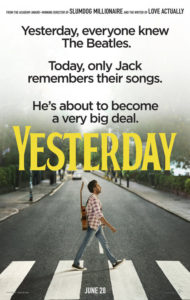
Though Yesterday, from director Danny Boyle (T2 Trainspotting), starts from a preposterously silly premise, it benefits from a winning, full-bore performance from lead actor Himesh Patel and a full-on commitment to its ridiculous conceit. Patel plays failed British singer/songwriter Jack Malik who, biking home from an argument with his manager Ellie (Lily James, Little Woods) one day, is hit by a bus as the entire world is suddenly hit by a global blackout. When he comes to, he discovers that everything is the same, except that the Beatles never existed (which, since they were a heavy influence on a lot of music that followed, doesn’t entirely work, but it’s still fun). There are a few other changes, which he discovers in the personal mayhem that follows. Soon, however, he is up on his feet, performing the songs of John, Paul, George and Ringo for all to hear, hailed as a genius. Triumph ensues, but at what cost? Penned by Richard Curtis (Love, Actually), the film is filled with excessively gooey sentiment towards the end, but never loses its charm.
Top Five Nonfiction Films (in alphabetical order):
Gay Chorus Deep South (David Charles Rodrigues): winner of the Documentary Audience Award

An inspiring tale of courage and compassion, Gay Chorus Deep South follows the San Francisco Gay Men’s Chorus – accompanied by the equally amazing Oakland Interfaith Gospel Choir – as they tour the states of the American South with the most repressive anti-gay cultures (and most recent anti-LGBTQ legislation) to promote a message of unity and love. Many of these men come from these same states, themselves, so it’s a fraught homecoming for some, as well, though surprises await those who think the receptions will all be negative. On the contrary, though haters gonna hate, love sometimes begets love, and quite a few ostensibly conservative Christian communities open their arms (and occasionally their churches) in welcome. The “Lavender Pen” tour (the official name) is a success, then, not only in terms of the great music it brings, but also because it reveals that behaving like a decent human being can generate an equal response. That seems obvious, but still comes as a surprise in these fractured times.
Making Waves: The Art of Cinematic Sound (Midge Costin) [the paragraph, below, is an adaptation of a longer review I wrote for Hammer to Nail]
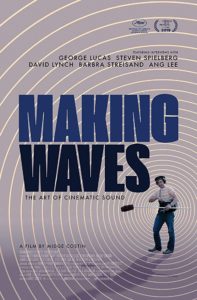
A comprehensive historical overview of the aural side of filmcraft, director Midge Costin’s Making Waves: The Art of Cinematic Sound explains the multiplicity of ways that audio affects picture. Interviewing a wide variety of specialists and using countless movie clips old and new, Costin, a sound editor with credits on films like Crimson Tide and The Rock, methodically walks us through the ins and outs of her discipline, leaving no doubt that movies are more than just a visual medium. Perfect for cinephiles, the documentary also offers an engaging journey for any who have ever pondered the mysteries of ambience, dialogue, effects, music and more. It’s about time, too, since other aspects of filmmaking – cinematography and editing, for example – have long had their own narratives. Bring on the noise (or the quiet, or whatever suits the story best), I say!

Our Time Machine (S. Leo Chiang/Yang Sun, 2019) [the paragraph, below, is an adaptation of a longer review I wrote for Hammer to Nail]
In S. Leo Chang and Yan Sun’s lyrical documentary Our Time Machine, we follow Chinese artist Maleonn as he develops a theatrical puppet drama inspired by his father’s fading memory. In the play, a young boy builds a time machine with which to transport himself and Dad back through various seminal points in their life together, hoping to thereby discover a remedy. What we see of both puppets and show is beautiful, though sadly in real life one cannot (yet) cure Alzheimer’s and related conditions so easily. It’s a bold effort, however, and results in not only a powerful staged spectacle but a lovely, meditative movie.
Picture Character (Ian Cheney/Martha Shane)
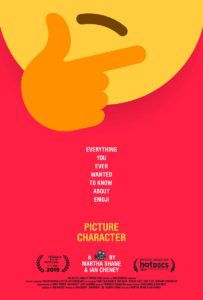
If it sometimes seems like there are emojis for everything, know that there are not. Until recently, there was no symbol for a hijab, nor one for a drop of blood or a drink of mate, though for some reason mermaids, mermen and genies are available, as are water drops (and a single water drop, too) and a glass of milk. Who decides what enters the visual lexicon of our day? Why, the Unicode Consortium, that’s who! Made up mostly of representatives from Silicon Valley tech companies, the group votes on new designs, submitted from around the world, approving 60 a year. Want to submit your own? Just check out the proposal guidelines. Directors Ian Cheney (The Search for General Tso) and Martha Shane (After Tiller), in their new documentary Picture Character, take us through first the history and then the current approval process, interviewing experts and aspirants along the way. It all makes for fascinating viewing, perfect for watching on either a 🎥 or 📺, or maybe even an 👁📞 …
Seahorse (Jeanie Finlay) [the paragraph, below, is an adaptation of a longer review I wrote for Hammer to Nail]
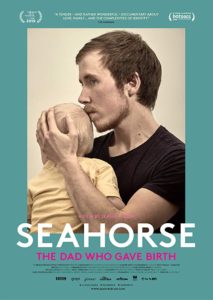
The seahorse, a marine fish, is the only vertebrate species on earth where the male becomes pregnant. As such, it becomes the perfect metaphor for the rare (at least for now) phenomenon among humans where a trans man decides to carry and birth his own child. Despite the fact that such men still have ovaries and other biologically female organs, the process of fertilization and pregnancy is not as easy as one might think, given the hormone treatments (including testosterone injections) that they undergo, which suppress the body’s original estrogen. But it is not impossible, as we discover in director Jeanie Finlay’s moving portrait of one such man, Freddy McConnell, following him throughout his lengthy, emotionally and physically grueling journey to become a parent. The resultant documentary, entitled simply Seahorse, teaches us profound truths about sex, gender identity, empathy and love in its brief, but comprehensive, 90 minutes.
And that’s it for my 2019 Tribeca coverage. See you next year!



